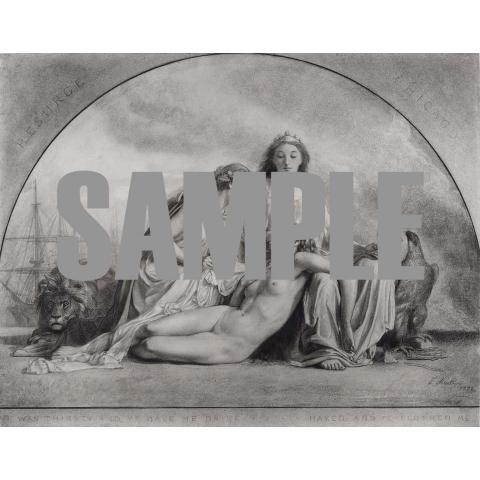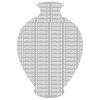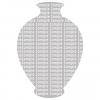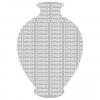Edward Armitage n Memory of the Great Fire at Chicago (Cartoon for the Mural Lunette in the Chic 1872
- Charcoal
- Paper
On October 8, 1871, one of the greatest fires of modern times broke out in Chicago. Engulfing the entire city within hours, it left over 90,000 people homeless and destroyed thousands of buildings, causing many people to flee into the water to escape the flames. Among the property destroyed were the proudest cultural and civic institutions of the city. While the financial center was rebuilt within a year and trade was greater in 1872 than it had been in 1870, it took over a decade for the city’s cultural resources to recover from the disaster. Many of the city’s best artists did not even return to Chicago for several years. Foreign aid poured in from around the world, with half coming from England alone. It is not surprising therefore, that in 1872 it was an English artist that should have designed the mural for City Hall commemorating the Great Fire. In his work, entitled In Memory of the Great Fire at Chicago, Edward Armitage captures in both form and text the sympathetic and supportive attitude of the people of Great Britain in the wake of this disaster.
Born in London, Edward Armitage went to Paris in 1835 to study at L’Ecole des Beaux-Arts in the prestigious atelier of Paul Delaroche (1797–1856). It was not long before Armitage became one of Delaroche’s favorite students and assisted the master in painting some of his major works. In 1842, Armitage for the first time exhibited in the Salon with his painting, Prometheus Enchained, and the very next year he felt able to return to his native England, where he competed for the decoration of the Houses of Parliament, a project which won him a substantial prize. He went on to win numerous other prizes and obtained commissions for his grand, historical schemes from both the Royal Family and for public decoration such as those in the House of Lords. From the 1840’s on, Armitage exhibited in the Royal Academy on a regular basis, gradually leaning towards more religious themes in his paintings. He was made an Associate of the Academy in 1867.
Seeing the gentle mastery of form and line that is evident in the execution of this drawing, it is no surprise that it was created and exhibited at the Royal Academy in 1872, the same year that Armitage was elected to become a Royal Academician. Armitage continued to paint murals with great success and to teach at the Royal Academy for many years, but this work, with its confident and graceful forms and its consummate draftsmanship, certainly represents the artist at the height of his career.
This drawing is accompanied by a privately published folio (18 3/4 x 26 3/4 in.) titled Selected Pictures and Drawings of Edward Armitage R.A. (1898), which includes 53 photogravures of Armitage’s paintings, including plate XLII, which was
made after the present drawing. The caption for the plate reads:
From the cartoon for the picture painted in 1872, which was bought by “The Graphic,” and presented to the City of Chicago. In the cartoon the recumbent figure is nude, in which particular it differs from the picture.
Another version of this work appears as the frontispiece in the second volume of A. T. Andreas’ History of Chicago from the Earliest Period to the Present Time in Three Volumes (1885). Volume II is subtitled Urbs Incinterata: From 1857 until the Fire of 1871. On the page facing the sepia image is the inscription,
“The original picture—a copy of which is given on the opposite page—was presented through the proprietors of the LONDON (England) GRAPHIC to the City of Chicago. After the immediate necessities of the sufferers by the fire of 1871 had been alleviated and it was announced that no more money from abroad would be needed, there remained a large sum in the hands of the proprietors of the LONDON GRAPHIC. Being unable to return the money to the donors, it was determined to use the same towards the purchase of this picture for the City of Chicago. Mr. Ed Armitage is the artist.”
The painting is titled, at the bottom of the image, Chicago and there is an indication that the work is owned by the Chicago Historical Society.





